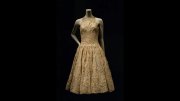On Oscar night, the exquisite gowns on movie stars like Charlize Theron, Julia Roberts, and Halle Berry command nearly as much attention as the Academy Awards themselves: red-carpet commentators intone the names of the designers who have clothed the parading beauties. And with amazing speed, American fashion pirates will have knock-off copies of these dresses in the stores, available at prices in the two- and three-figure instead of the four- or five-figure range.
This would not happen in Europe. There, intellectual-property laws have long protected fashion designers against unauthorized copying of their work. American designers enjoy no such rights. U.S. copyright law shields the work of authors, visual artists, musicians, photographers, and filmmakers from piracy, but leaves other areas, like fashion design, open to appropriation. (Trademark law does protect registered names and images such as “Gucci” and the Nike swoosh.) “The U.S. copyright law excludes ‘useful’ articles,” says assistant professor of law Jeannie Suk, J.D. ’02, a senior fellow in the Humanities Center. “That includes things like apparel, shoes, and chairs.”
Traditionally, Suk explains, “In Europe you had designers, and in America, you had copyists. American clothing manufacturers would go to Paris and Milan to find cutting-edge styles and bring them back to the United States. It’s only recently that we’ve begun to think of American designers as exciting originators who rival or even surpass the Europeans. Think of Jacqueline Kennedy, who favored European designers, and Michelle Obama, who wears mostly American designers.”
In “The Law, Culture, and Economics of Fashion,” published last year in the Stanford Law Review, Suk and coauthor C. Scott Hemphill ’94, of Columbia Law School, argue for providing fashion designers with a degree of copyright protection. Indeed, since 2006, legislators have introduced three bills in the U.S. Congress to protect designers. None of them passed. “All three protected too much,” Suk believes.
She and Hemphill recommend a narrowly defined right of ownership, one that would ban virtually identical replicas but permit a wide range of designs that might substantially resemble the original. Senator Charles Schumer ’71, J.D. ’74 (D-NY), is now preparing a new design-copyright bill, and his staff have solicited Suk’s advice.
There is a delicate balance involved, because fashion intrinsically involves trends--designers and customers moving in the same direction together--as well as individualistic expression. “Fashion is not the same as books and music,” Suk says. “Part of the point of fashion is to look kind of like others, while still being distinctive.”
“There are companies that knock off, and others that participate in trends,” she explains. The “most notorious copyist” is Forever 21, a knock-off retailer that does not operate in Europe but does business in the United States, and even here is a frequent defendant in copyright or trademark litigation. In contrast, Zara, a “fast-fashion” company that moves clothes rapidly into the marketplace, sells its products in both the United States and Europe and, though firmly on-trend, produces not precise copies, but adaptations or interpretations developed by in-house designers. The researchers say that from 2003 through 2008, Zara was not sued for infringement even once.
A design copyright law might especially benefit innovative younger creators, “who have fewer tools to prevent copying,” Suk says. Customers of such smaller firms generally buy a garment because they like the design per se, and care little about its label. In contrast, buyers of a Gucci product want it in part “because it is Gucci,” says Suk. “There’s the cachet associated with that.” It’s a cachet that a knock-off cannot confer.
The interaction of law and culture fascinates Suk, who has a doctorate in literary studies from Oxford and last year published At Home in the Law: How the Domestic Violence Revolution Is Transforming Privacy . She and Hemphill modeled their design-right concepts on work by professor of law Lawrence Lessig, whose recent book Remix: Making Art and Commerce Thrive in the Hybrid Economy argues for a copyright stance that allows individuals to download, for example, video and audio recordings and re-edit them into original works. “The process of creativity involves looking back on something created before and using it,” Suk explains. “At the same time, if you don’t give people incentives to create original work, they won’t invest in that activity. What’s wrong with the current copyright law is that we’re protecting too little in an area like fashion, for example, but protecting too much in other areas of creative work.”










